Drosophila atypical protein kinase C associates with Bazooka and controls polarity of epithelia and neuroblasts
- PMID: 10995441
- PMCID: PMC2150710
- DOI: 10.1083/jcb.150.6.1361
Drosophila atypical protein kinase C associates with Bazooka and controls polarity of epithelia and neuroblasts
Erratum in
- J Cell Biol. 2004 May 24;165(4):following 589
Abstract
The establishment and maintenance of polarity is of fundamental importance for the function of epithelial and neuronal cells. In Drosophila, the multi-PDZ domain protein Bazooka (Baz) is required for establishment of apico-basal polarity in epithelia and in neuroblasts, the stem cells of the central nervous system. In the latter, Baz anchors Inscuteable in the apical cytocortex, which is essential for asymmetric localization of cell fate determinants and for proper orientation of the mitotic spindle. Here we show that Baz directly binds to the Drosophila atypical isoform of protein kinase C and that both proteins are mutually dependent on each other for correct apical localization. Loss-of-function mutants of the Drosophila atypical isoform of PKC show loss of apico-basal polarity, multilayering of epithelia, mislocalization of Inscuteable and abnormal spindle orientation in neuroblasts. Together, these data provide strong evidence for the existence of an evolutionary conserved mechanism that controls apico-basal polarity in epithelia and neuronal stem cells. This study is the first functional analysis of an atypical protein kinase C isoform using a loss-of-function allele in a genetically tractable organism.
Figures
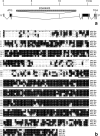
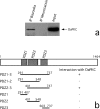

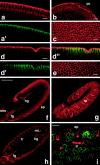
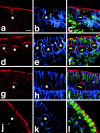

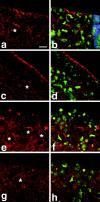
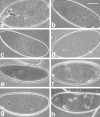
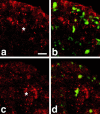
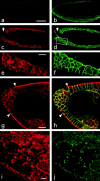
Similar articles
-
Drosophila aPKC regulates cell polarity and cell proliferation in neuroblasts and epithelia.J Cell Biol. 2003 Dec 8;163(5):1089-98. doi: 10.1083/jcb.200306079. Epub 2003 Dec 1. J Cell Biol. 2003. PMID: 14657233 Free PMC article.
-
Differential functions of G protein and Baz-aPKC signaling pathways in Drosophila neuroblast asymmetric division.J Cell Biol. 2004 Mar 1;164(5):729-38. doi: 10.1083/jcb.200309162. Epub 2004 Feb 23. J Cell Biol. 2004. PMID: 14981094 Free PMC article.
-
DmPAR-6 directs epithelial polarity and asymmetric cell division of neuroblasts in Drosophila.Nat Cell Biol. 2001 Jan;3(1):43-9. doi: 10.1038/35050550. Nat Cell Biol. 2001. PMID: 11146625
-
The cell cycle machinery and asymmetric cell division of neural progenitors in the Drosophila embryonic central nervous system.Novartis Found Symp. 2001;237:139-51; discussion 151-63. doi: 10.1002/0470846666.ch11. Novartis Found Symp. 2001. PMID: 11444041 Review.
-
Par-3 family proteins in cell polarity & adhesion.FEBS J. 2022 Feb;289(3):596-613. doi: 10.1111/febs.15754. Epub 2021 Mar 3. FEBS J. 2022. PMID: 33565714 Free PMC article. Review.
Cited by
-
Signaling pathways in cell polarity.Cold Spring Harb Perspect Biol. 2012 Jun 1;4(6):a009654. doi: 10.1101/cshperspect.a009654. Cold Spring Harb Perspect Biol. 2012. PMID: 22553378 Free PMC article.
-
The cell polarity protein ASIP/PAR-3 directly associates with junctional adhesion molecule (JAM).EMBO J. 2001 Jul 16;20(14):3738-48. doi: 10.1093/emboj/20.14.3738. EMBO J. 2001. PMID: 11447115 Free PMC article.
-
Dynamics of PAR Proteins Explain the Oscillation and Ratcheting Mechanisms in Dorsal Closure.Biophys J. 2018 Dec 4;115(11):2230-2241. doi: 10.1016/j.bpj.2018.10.014. Epub 2018 Oct 24. Biophys J. 2018. PMID: 30446158 Free PMC article.
-
Widely conserved signaling pathways in the establishment of cell polarity.Cold Spring Harb Perspect Biol. 2009 Aug;1(2):a001370. doi: 10.1101/cshperspect.a001370. Cold Spring Harb Perspect Biol. 2009. PMID: 20066082 Free PMC article. Review.
-
PKClambda in liver mediates insulin-induced SREBP-1c expression and determines both hepatic lipid content and overall insulin sensitivity.J Clin Invest. 2003 Sep;112(6):935-44. doi: 10.1172/JCI18816. J Clin Invest. 2003. PMID: 12975478 Free PMC article.
References
-
- Adams M.D., Celniker S.E., Holt R.A., Evans C.A., Gocayne J.D., Amanatides P.G., Scherer S.E., Li P.W., Hoskins R.A., Galle R.F. The genomic sequence of Drosophila melanogaster . Science. 2000;287:2185–2195. - PubMed
-
- Baumgartner S., Littleton J.T., Broadie K., Bhat M.A., Harbecke R., Lengyel J.A., Chiquet-Ehrismann R., Prokop A., Bellen H.J. A Drosophila neurexin is required for septate junction and blood-nerve barrier formation and function. Cell. 1996;87:1059–1068. - PubMed
Publication types
MeSH terms
Substances
LinkOut - more resources
Full Text Sources
Other Literature Sources
Molecular Biology Databases

